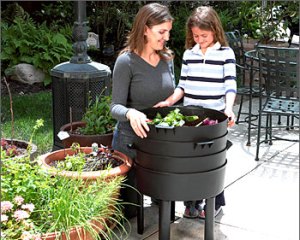We just read a great article on gardenguides.com and thought we would share some of their composting tips with you. While compost is very easy to maintain and pretty much takes care of itself, there are some small things you can do to make sure your compost pile is thriving and producing nutrient-filled soil.
Compost Care:
Keep your compost pile in a semi-shaded area in order to keep it from drying out too much. Make sure to sprinkle your compost with a garden hose when it appears dry. Remember to keep your compost moist, but not wet because beneficial organisms cannot survive in soggy conditions.
Using your Compost:
When your compost is ready, you can mix it into the soil before planting or use it as mulch. Either way, make sure to use it as soon as possible because the longer it sits, the fewer nutrients it contains.
Quicken the Composting Process:
If you would like to speed up the composting process, turn the pile once a week to allow oxygen into the center of the pile, where it encourages growth of bacteria and fungi. Also, particle size has a lot to do with the decomposition speed, so try to make your pieces of compost smaller if you want it to go by faster.
What to Compost:
-kitchen waste
-lawn clippings (use thin layers so they don’t mat down)
-chopped leaves
-shredded branches
-garden plants (use disease-free plants)
-shredded paper
-weeds
-straw or hay
-newspaper
-wood ash (sprinkle lightly between layers)
-tea leaves and coffee grounds
What Not to Compost:
-meat scraps and fatty trash
-excessive wood ashes
-sawdust (generally slows the decomposition of the pile)
Potential Problems:
-If there is an unpleasant odor coming from your compost it is because there is either too much nitrogen in the pile, compaction, or the pile has been over watered. To solve this issue of too much nitrogen, add high carbon material such as straw, pine needles, or grass trimmings. to solve the compaction problem, aerate the pile and to reverse the effects of overwatering, add dry leaves or wood chips to soak up the water and aerate.
-If the pile is not heating up it could be due to lack of nitrogen, it needs to be turned, low moisture, or the compost is finished. If there is not enough nitrogen, add fresh manure, grass clippings, or blood meal and mix the pile. If the pile needs to be turned, mix the compost by bringing outside material to the center. If there is low moisture make sure to water the compost so the moisture gets to the center of the pile. Poke deep holes in the pile before watering. If the compost is finished it will smell earthy rather than rotten or moldy and it will be dark and crumbly.
-If the compost is damp and only the center is warm it is because the pile is too small and you will need to add more compost material.

Finished Compost






























You must be logged in to post a comment.